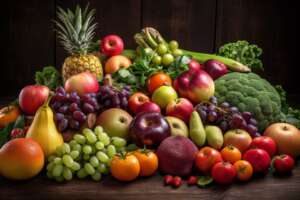
When you’re pregnant, eating a healthy diet is essential for both you and your growing baby. A balanced diet can help ensure that you’re getting all the nutrients you need to support your baby’s development while also keeping you healthy and energized throughout your pregnancy.
So what exactly does a healthy pregnancy diet look like? Here are some tips to help you make the most of your meals during this special time:
Include plenty of fruits and vegetables Fruits and vegetables are packed with important vitamins and minerals that are essential for both you and your baby. They also provide fiber, which can help prevent constipation, a common pregnancy symptom. Aim to make half of your plate fruits and vegetables at every meal, and try to include a variety of colors and types to get the widest range of nutrients.
Choose whole grains Whole grains like brown rice, quinoa, and whole-wheat bread and pasta are rich in fiber, which can help keep you feeling full and satisfied. They also provide important nutrients like B vitamins and iron, which are essential for fetal growth and development. Aim to make at least half of your grains whole grains.
Get enough protein Protein is important for building and repairing tissues, and it’s especially important during pregnancy to support your baby’s growth and development. Good sources of protein include lean meats, poultry, fish, beans, nuts, and tofu. Aim to include a source of protein at every meal and snack.
Include dairy products Dairy products like milk, cheese, and yogurt are rich in calcium, which is essential for building strong bones and teeth. They also provide other important nutrients like vitamin D and protein. Choose fat-free or low-fat dairy products to keep your saturated fat intake in check.
Limit added sugars, saturated fat, and sodium While it’s important to eat a variety of foods during pregnancy, there are some foods and beverages you should limit or avoid. These include those high in added sugars, saturated fat, and sodium. Examples include candy, soda, fried foods, and processed meats. Instead, opt for whole, nutrient-dense foods that will provide you and your baby with the most benefits.
Remember, every pregnancy is unique, and your nutritional needs may vary based on factors like your age, weight, and overall health. Be sure to talk to your healthcare provider about any specific dietary recommendations they may have for you. With the right nutrition, you can help support a healthy pregnancy and give your baby the best start in life.
Here are the Top 10 Foods for your pregnancy:
Eggs

Eggs are an excellent source of protein, which is essential for the growth and development of your baby. The amino acids that make up protein are the building blocks of the cells in your body and your baby’s, so it’s important to get enough protein in your diet during pregnancy.
In addition to protein, eggs are also rich in a variety of vitamins and minerals, such as choline. Choline is particularly important for your baby’s brain and spinal cord development, and can help prevent certain birth defects. It’s worth noting that choline is primarily found in the yolk of the egg, so be sure to include it in your meals.
One easy and delicious way to enjoy eggs is by making a frittata. Simply combine eggs with whatever veggies and cheese you have on hand, and you’ll have a nutritious and filling meal. Frittatas are also a great way to use up any leftovers you may have from previous meals, making them a budget-friendly option for expectant moms.
When cooking eggs, it’s important to make sure they are fully cooked before consuming. Raw or undercooked eggs can be a source of salmonella, which can be harmful to both you and your baby. You can check if an egg is fully cooked by making sure the whites and yolks are firm and not runny.
Salmon

Salmon is packed with omega-3 fatty acids, which are essential for your baby’s brain development. These healthy fats can also improve your mood and reduce your risk of depression. In addition to omega-3s, salmon is a great source of protein and vitamin D, both of which are important for healthy bone and teeth development in your baby.
When it comes to choosing fish during pregnancy, it’s important to be aware of the risks associated with mercury exposure. Luckily, salmon is considered a low-mercury option, as are other fish like herring, trout, anchovies, sardines, and shad. The American Pregnancy Association recommends that pregnant women eat 8 to 12 ounces of seafood per week, which can be a mix of low-mercury fish and shellfish.
One delicious way to incorporate salmon into your pregnancy diet is by grilling it or baking it with your favorite seasonings. You can also try topping a salad with some grilled salmon or using it in a stir-fry with lots of colorful veggies. Canned salmon is another convenient option, which can be used to make salmon burgers or patties, and even added to pasta dishes.
Beans

Beans and legumes, such as lentils, peas, and peanuts, are excellent sources of protein, iron, folate, potassium, and magnesium. They are also high in fiber, which can help prevent constipation and hemorrhoids, two common pregnancy discomforts.
Beans are versatile and can be included in various dishes to make your meals more nutritious. Toss cooked edamame (soybeans) into salads, soups, or stir-fries for a protein and fiber boost. Edamame is also an excellent source of essential fatty acids, making it an ideal snack to munch on.
Another great option is to add cooked black beans to your burritos, tacos, or salads. Chickpeas can be added to your soups, stews, or made into hummus for a quick snack. Pinto beans can be used to make a vegetarian chili, while navy beans can be used in casseroles or salads.
Sweet Potatoes

One of the biggest benefits of sweet potatoes is their high vitamin A content. This vitamin is essential for your baby’s healthy growth and development, especially for the development of bones, lungs, eyes, and skin. Plus, sweet potatoes are also an excellent source of vitamin C, which is important for boosting your immune system and keeping you and your baby healthy.
But that’s not all. Sweet potatoes are also a good source of manganese, a mineral that helps support healthy bone development, and vitamin B6, which may help alleviate morning sickness. Additionally, sweet potatoes are high in potassium, which can help regulate your blood pressure and prevent swelling during pregnancy.
Finally, sweet potatoes are a great source of fiber, which can help prevent constipation and keep you feeling full between meals. And, if you leave the skin on, you’ll get even more fiber and nutrients.
So, how can you incorporate sweet potatoes into your pregnancy diet? Here are a few ideas:
- Baked sweet potatoes: Simply wash and pierce sweet potatoes with a fork, then bake in the oven until tender. You can top with butter, cinnamon, or even a sprinkle of brown sugar for a sweet treat.
- Sweet potato fries: Cut sweet potatoes into thin strips and bake in the oven for a healthier alternative to regular French fries.
- Sweet potato hash: Dice sweet potatoes and sauté with onions and your choice of protein (such as ground turkey or sausage) for a tasty breakfast or brunch option.
- Sweet potato soup: Puree cooked sweet potatoes with vegetable broth and your favorite seasonings for a comforting and nutrient-rich soup.
With so many options, there’s no reason not to add sweet potatoes to your pregnancy meal plan. Not only will they satisfy your taste buds, but they’ll also give your baby the nutrients they need to grow and thrive.
Whole Grains

Whole grains are the entire seed of a plant, including the bran, germ, and endosperm. They come in various forms such as oats, barley, quinoa, wheat, and brown rice.
Why are whole grains important during pregnancy?
Whole grains are high in fiber, which helps regulate digestion and prevents constipation – a common issue during pregnancy. They are also rich in B vitamins, iron, and folic acid, which are essential for a healthy pregnancy. Folic acid is particularly crucial during early pregnancy, as it helps prevent birth defects of the brain and spine.
Whole grains also contain phytonutrients, which are plant compounds that have antioxidant properties. These compounds help protect your cells and reduce the risk of chronic diseases, such as heart disease and cancer.
How can I incorporate whole grains into my pregnancy diet?
Switching from white bread to whole grain bread is an easy way to start incorporating whole grains into your diet. You can also choose whole grain versions of pasta, cereal, and crackers.
Experiment with different types of whole grains such as quinoa, brown rice, and barley. Add them to soups, salads, or as a side dish to your main meal. Rolled oats are also an excellent source of whole grains and can be used to make oatmeal or added to smoothies.
Walnuts

One of the most significant benefits of walnuts is that they are a great source of plant-based omega-3 fatty acids. Omega-3s are essential for your baby’s brain and eye development, and they can even help improve your mood during pregnancy. Walnuts also contain magnesium, which is essential for maintaining healthy blood pressure levels and reducing the risk of preterm birth.
In addition to omega-3s and magnesium, walnuts are also high in fiber and protein. Fiber can help prevent constipation and keep you feeling full, while protein is crucial for the growth and development of your baby’s cells.
One of the best things about walnuts is how versatile they are. You can add them to your oatmeal or yogurt in the morning, toss them into a salad for lunch, or grab a handful as an on-the-go snack. You can also try other nuts, like almonds and pistachios, or nut and seed butters, like tahini, for similar benefits.
Of course, it’s important to remember that nuts are also high in calories, so be mindful of your portion sizes. A small handful of walnuts – about 1 ounce – is a good serving size to aim for.
Incorporating walnuts into your pregnancy diet is an easy and delicious way to get important nutrients for both you and your baby. So go ahead and enjoy a handful of these nutritious nuts today!
Greek Yoghurt

One of the benefits of Greek yogurt over regular yogurt is its higher protein content. With twice the amount of protein compared to regular yogurt, Greek yogurt is a great way to help meet your increased protein needs during pregnancy. Protein is important for the development of your baby’s muscles, bones, and organs, and it can also help you feel fuller for longer, which can help you manage your weight during pregnancy.
Greek yogurt is also a good source of probiotics, which are beneficial bacteria that can help support your digestive health. During pregnancy, hormonal changes can make you more susceptible to digestive issues, such as constipation, bloating, and heartburn. Eating foods like Greek yogurt that contain probiotics can help promote a healthy balance of bacteria in your gut and alleviate some of these uncomfortable symptoms.
In addition to protein and probiotics, Greek yogurt is also a rich source of important nutrients like B vitamins, phosphorus, and calcium. Calcium, in particular, is essential during pregnancy for building your baby’s bones and teeth. It can also help keep your own bones strong and healthy, which is especially important as your body prepares for childbirth.
One of the great things about Greek yogurt is that it’s a versatile ingredient that can be used in many different ways. You can enjoy it plain or sweetened with a drizzle of honey or some fresh fruit. It also makes a great addition to smoothies, overnight oats, or parfaits. And if you’re looking for a savory snack, try adding some herbs and spices to your Greek yogurt and using it as a dip for vegetables or pita chips.
Remember, though, that not all Greek yogurt is created equal. Some brands may contain added sugars or artificial ingredients, so it’s important to read the label carefully and choose a brand that’s low in sugar and high in protein. Look for plain Greek yogurt, and add your own sweetness and flavor with fresh fruit or a touch of honey.
Broccoli

Broccoli is a superfood! It’s packed with vitamins A, C, and K, as well as calcium, iron, and folate, making it an excellent addition to your pregnancy diet. Broccoli also contains antioxidants and fiber, which can help ease constipation.
To incorporate broccoli into your diet, try steaming it and adding it to salads, stir-fries, or omelets. You can also puree it and mix it into pasta sauces or soups. Broccoli is a versatile vegetable that pairs well with many flavors, making it easy to incorporate into your meals.
Dark leafy greens like spinach, kale, and Swiss chard are also prenatal superfoods. They’re loaded with vitamins and nutrients, including vitamins A, C, and K, as well as calcium, iron, and folate. Dark leafy greens are also rich in antioxidants and fiber, which can help ease constipation.
To increase the amount of dark leafy greens in your diet, chop them coarsely and add them to smoothies, soups, or stir-fries. You can also sauté them with garlic and olive oil for a delicious and nutritious side dish.
Lean Meats

Meat is a great source of iron, which is especially important during pregnancy as it helps deliver oxygen to your cells and your growing baby’s cells. It’s also a good source of B vitamins, including B12, which is essential for brain development, and zinc, which helps support a healthy immune system.
However, it’s important to choose lean cuts of meat that are around 95 to 98 percent fat-free. This will help you get the protein and nutrients you need without too much saturated fat, which can increase your risk of certain health problems.
On the other hand, you should avoid deli meats and hot dogs unless they’re heated until steaming hot. These products can be contaminated with bacteria and parasites such as listeria, toxoplasma, or salmonella, which can be harmful to you and your baby.
To make sure you’re getting the right nutrients from meat, try incorporating it into a variety of meals. Grilled chicken breast or baked salmon can be paired with roasted vegetables for a nutritious dinner, while lean beef can be used in a stir-fry with lots of colorful veggies.
Fruits and Vegetables

Eating a variety of colorful fruits and vegetables is essential during pregnancy. They provide a wide range of nutrients that are important for both you and your baby’s health. Each color group offers different vitamins, minerals, and antioxidants that can boost your immune system, help with digestion, and aid in the development of your baby’s organs and tissues.
Green vegetables, such as broccoli, kale, and spinach, are rich in folate, which is important for preventing birth defects in the baby’s brain and spinal cord. They also contain vitamin K, which is essential for blood clotting and helps build strong bones.
Red and orange fruits and vegetables, such as carrots, sweet potatoes, and red peppers, are high in beta-carotene, which your body converts to vitamin A. Vitamin A is important for your baby’s vision, immune system, and bone growth.
Yellow and green vegetables, like corn and peas, are a good source of vitamins C and K, as well as folate and fiber. These nutrients help support healthy digestion and can even help reduce the risk of certain birth defects.
Blue and purple fruits, such as blueberries, blackberries, and grapes, are loaded with antioxidants that can help protect your cells from damage. They’re also high in fiber, which can help prevent constipation.
When it comes to incorporating these colorful fruits and vegetables into your diet, salads are an easy way to mix and match different colors and flavors. You can add greens, such as spinach or kale, and toss in some bell peppers, carrots, and tomatoes for a colorful and nutritious salad.
Another way to incorporate these colorful foods is by adding them to smoothies. You can blend together berries, kale, and bananas for a delicious and nutritious breakfast smoothie.
Eating a variety of colorful fruits and vegetables is a simple and tasty way to ensure that you and your baby are getting the nutrients you need during pregnancy. So, don’t be afraid to experiment with different colors and flavors to create a healthy and balanced diet.
Olivia S
As an experienced writer and mother, I've discovered my true passion lies in the world of parenting. I understand firsthand the challenges and joys of raising children, and I'm committed to sharing my experiences and insights with other parents. With my degree in English and years of experience as a freelance writer, I've developed my unique writing voice that resonates with my readers. My approach to writing is warm and compassionate, and I aim to provide practical advice and support to parents navigating the ups and downs of parenthood. Whether I'm sharing tips on sleep training or exploring the latest trends in children's education, I write from the heart and strive to create informative and engaging content.




3 Comments